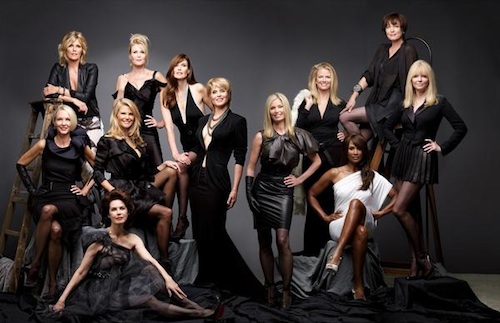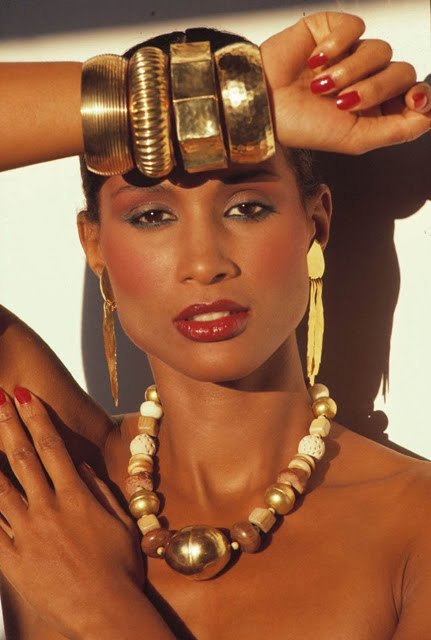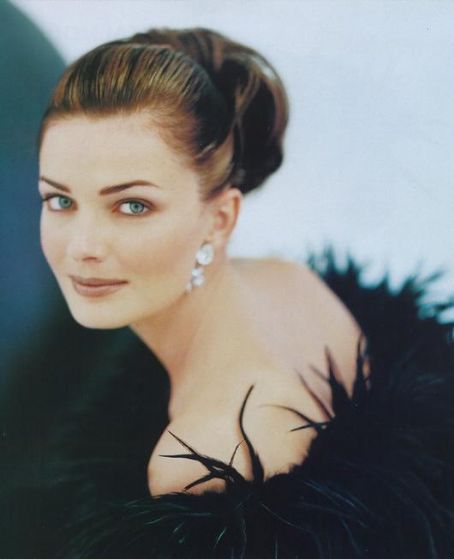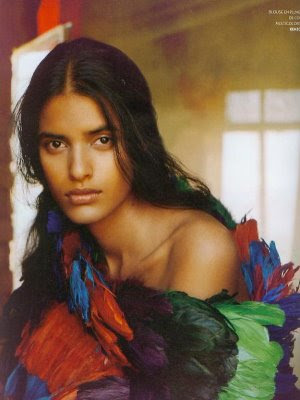
[Editor’s Note: the post below appears today on the front page of The Huffington Post.]
By Govindini Murty. They’re among the most iconic faces of the second half of the twentieth century. Isabella Rossellini, Beverly Johnson, Paulina Porizkova, and their supermodel sorority helped to shape public perceptions of beauty and womanhood at a time of rapid expansion in the mass media. Their faces graced thousands of magazine covers and they were role models to millions of young women.
But was the rise of the supermodel a sign of female empowerment, or of female objectification?
About Face: Supermodels Then and Now, an insightful new documentary by director and photographer Timothy Greenfield-Sanders available on HBO on-demand through September 3 and HBO Go through 2013, interviews sixteen of these supermodels about the true nature of beauty in an age of consumerism and mass media.
As alluded to in About Face, the irony that underlies the modeling profession is that it should lead to both the empowerment and objectification of women. On the one hand, the mass distribution of images of female models through fashion magazines, ads, and other media in the past century has led to women becoming quite literally more visible in today’s world – with that visibility being an affirmation of their femininity and right to exist as women in the public sphere. In contrast to this, from the Puritans to the Taliban, misogynistic societies through history have restricted sensual or beautiful images of women as a prelude to denying their basic right to participate in public life, citing women’s beauty as a “corrupting” influence on social morality. The predominance of beautiful images of women in Western culture has thus affirmed the broader right of women to exist in public as feminine and not as neutered beings.
On the other hand, modeling has also had the effect of objectifying women by focusing on external surfaces, and at times unnatural standards of beauty. In About Face, Isabella Rossellini asks of the pressure for women to undergo plastic surgery: “Is this the new foot-binding? It’s misogyny to say that older women are unattractive.” Objectification can also lead to racism by dehumanizing people and imposing narrow standards of ‘beauty’ or ‘normalcy.’ Model and agent Bethann Hardison describes in About Face trying to book African-American models for runway shows in the ’70s and ’80s, only to be told by the casting agents that such models weren’t their “aesthetic.” As Hardison explains “‘Aesthetic’ is borderline for racist.”
I spoke with director Timothy Greenfield-Sanders about some of these issues at the LA Film Festival’s screening of About Face. The interview has been edited for length.

GM: What drew you to these ladies? I know you met them initially at a party in New York, but what did you find so magical about them?
TGS: I think when I met them at that party … I immediately got a sense of how smart they were. You know, the cliché is that you either have brains or beauty, but you don’t have both. Well, they seemed to have both. It really makes it an interesting film. And I thought that people weren’t aware of that. I have two young daughters who knew who they were. But many young people today who are so interested in fashion, they don’t know the history of it and of these iconic women.
GM: What has changed about modeling? You mentioned in the screening that these models were so unique, whereas today the models and their careers seem more transient. Why is there this disparity today versus back then?
TGS: I think that it was a smaller world then. I think there was a warmer relationship between the models and the designers and even the businesspeople involved. It was not so cut-throat and not so corporate. And I think today it’s just big business and big money, and I don’t think the human relationship is there as much. I think it’s very changed.
GM: Do you think a big part of that is the issue of covers – that the actresses are taking over magazine covers?
TGS: Yes.
GM: It’s such a striking change. What has that done to the morale of the models? Does it make a big difference behind the scenes?
TGS: I’m not sure I can answer that because it’s not my world, exactly. But I know certainly it was huge in those days to have covers, because covers were the definition of success. And the cover of Vogue was the ultimate success. So when Beverly Johnson got on the cover of Vogue – the first black woman to do so [in August, 1974], that was a big deal. And today – that doesn’t happen for models.

GM: I thought it was very interesting what Dayle Haddon said that it wasn’t just that she thought she was the prettiest – in fact she didn’t quite fit into the physical type that was popular at the time, but that she brought something else to the picture.
TGS: She brought something else. And Dayle Haddon had to struggle because she wasn’t the look of the moment. She was a very smart woman and she figured out a way to add something more to the picture.
GM: Do you think the reason that those models from that era were so powerful – we’re talking the ’70s and ’80s, was because they were often muses for the designers they were working with?
TGS: Yes, exactly.
GM: I think of Yves St. Laurent and models like Khadija Adams, or even Catherine Deneuve in the ’60s who was dressed by St. Laurent for Belle de Jour. I think of Calvin Klein and Brooke Shields, they were so intimately tied together.
TGS: They were very connected to the designers. As Karen Bjornson said, Halston cut the clothes on her. So it was very much an intimate experience where they got to know these women, they hung out with them, they were very much part of their lives. One of the interesting questions I heard in the screening was about how [the models] sacrificed family and I think that to some extent that happens. You can’t go out every night and be with the designers and hang out in their world [and still have a family life]. It’s not a world about children and family. It’s a world about – something else.
GM: Beauty, decadence, glamor –
TGS: Yes, exactly.
GM: Art.
TGS: And you can’t have both of them sometimes. It’s very hard.
GM: Do you think it’s tied in to the fact that there are more women fashion designers today? Miuccia Prada is incredible, and you think of the women designer of the Missoni family – are they perhaps more the icons then, rather than the women that they’re dressing?
TGS: I think Chad [his producer] would have a better answer than I. But I think that what surprised me making the film was how extraordinary these women were. And I shouldn’t have been surprised because I don’t think you can become what they became without being more than just a pretty face and a great body – you had to have something else. And Calvin says it at the beginning of the film: they had something special. You know they did. They had something special, and I’m amazed by them.
GM: Are we going to see greater diversity in the modeling industry? It’s nice to see Indian models [like Lakshmi Menon] in Vogue.

TGS: And there’s Liya Kebede [who’s Ethiopian]. Yeah, I think it has to change. It’s going to change – much more, as in the next dozen years the diversity of America changes. So it’ll change. It just takes a longer time than you’d think.
GM: And there may be more Chinese models because of expansion into China. As those international markets become more important they have to have models that look like their customers.
TGS: A lot of those markets want American-looking models.
GM: That’s rather ironic. I was also fascinated by your story about going to the AFI and studying to be a filmmaker – and then taking photos of Bette Davis and Alfred Hitchcock, with them then telling you how to take pictures – and then also getting to know [legendary Hollywood portrait photographer] Hurrell. Those are such extraordinary experiences. How did that inspire you? What fed into your creativity?
TGS: I left film because I felt that photography was my art. It was something I could do on my own, whereas film was so collaborative. I thought as a photographer I could make something that was artistic and that was mine, and I liked that. And it wasn’t until I got back into film and I have very small crews and I could do very tiny filmmaking that wasn’t 100 people that I still felt that I was making something artistic as a filmmaker. So, you know, I’m an artist, and whether it’s photography or film, I want my voice to be there and I think my voice is very strong in this film.
GM: It is, and these women really opened up to you. I thought it was fascinating what Isabella Rossellini said about beauty, and about not wanting to get plastic surgery because “was that a form of foot binding?” – another form of misogyny.
TGS: Right, right.
GM: That was very telling. What do you think of that?
TGS: I think people need to watch this film several times. It’s very dense and there’s so much information in it and there are so many extraordinary statements. They come and go so quickly that you go “Oh my God,” and you’re thinking about that and then you’re on to the next one. So I think it’s a film that deserves multiple viewings because it’s a very intelligent film and with very intelligent people. There’s a lot of density to it.
GM: These women have a lot of wisdom – and I think as women get more power in the media and in society I think you’ll see less pressure for there to be 15 year old models only. I would rather see a women in her 20s, 30s, 40s, 50s, selling something.

TGS: I love what Isabella said about how they’re selling to young people because they’re more malleable. That’s what she was saying. It’s not so much that older people want to look young, but they target young people because they can sell to them more easily.
GM: I’d rather buy from a more mature woman –
TGS: Yeah, but you’re special. [We both laugh.]
TGS: You know, it’s funny because I think marketers in the end at Lancome realized they made a mistake. [Lancome let go Isabella Rossellini in 1996, after she had been the iconic face of the brand for fourteen years. Lancome’s explanation was that Rossellini was too old, but many felt that she was still at the height of her beauty.]
GM: They did, they did.
TGS: They did, and they know it.
By the end of About Face, what becomes clear is that these supermodels didn’t succeed just because of their looks, but also because they conveyed an inner quality of soul in their photographs. As Calvin Klein says in the film: “They had something inside that came through … they had character, they had personality. Those qualities never age.” Supermodel Dayle Haddon explains: “Through a picture I felt I could communicate … beauty is bringing more to the photo than just the outside.” And Cheryl Tiegs adds: “I always thought education was the key to beauty.”
Perhaps this is the larger message of why models, actresses, singers and other women whose images are glamorized in the media play such an important role in the visual imagination of our culture: as paradoxical as it may seem, their photos lead to a consideration of something deeper within ourselves. As Marshall McLuhan wrote in Understanding Media, “the photograph really transcends the pictorial by capturing the inner gestures and postures of both body and mind.” Thus, by dwelling on women’s faces, we’re also dwelling on women’s souls, their psychology, and their inner mystery.
Posted on August 31st, 2012 at 8:19am.
In About Face, Isabella Rossellini asks of the pressure for women to undergo plastic surgery: “Is this the new foot-binding? It’s misogyny to say that older women are unattractive.”
That’s more than a bit hypocritical, isn’t it, in that she made her name and fortune through nothing more than her external beauty, i.e. the beauty of her youth.
Congrats GM for being published in THP. A very nice interview as well with some interesting points.
Comments: The coupling of objectification with plastic surgery was right on, but I wonder if the modern “facial mask” makeup isn’t pretty much the same thing?
If education is the key to beauty, then they perhaps should be trolling for models at Cal Tech. 😉
Also, I notice that the documentary doesn’t seem to have anything to say about the propagation of an aesthetic that requires dysfunctional dietary practices and inflicts image issues on young women. I suppose it would have been impolitic to mention that.